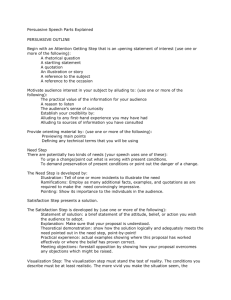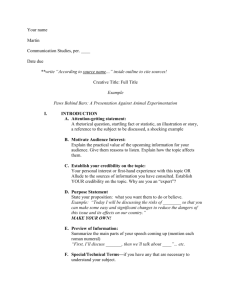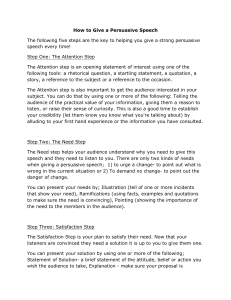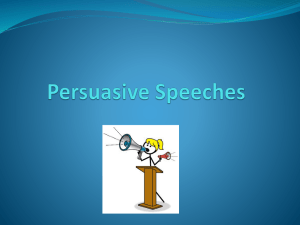TEDx Persuasive Speech Outline
advertisement
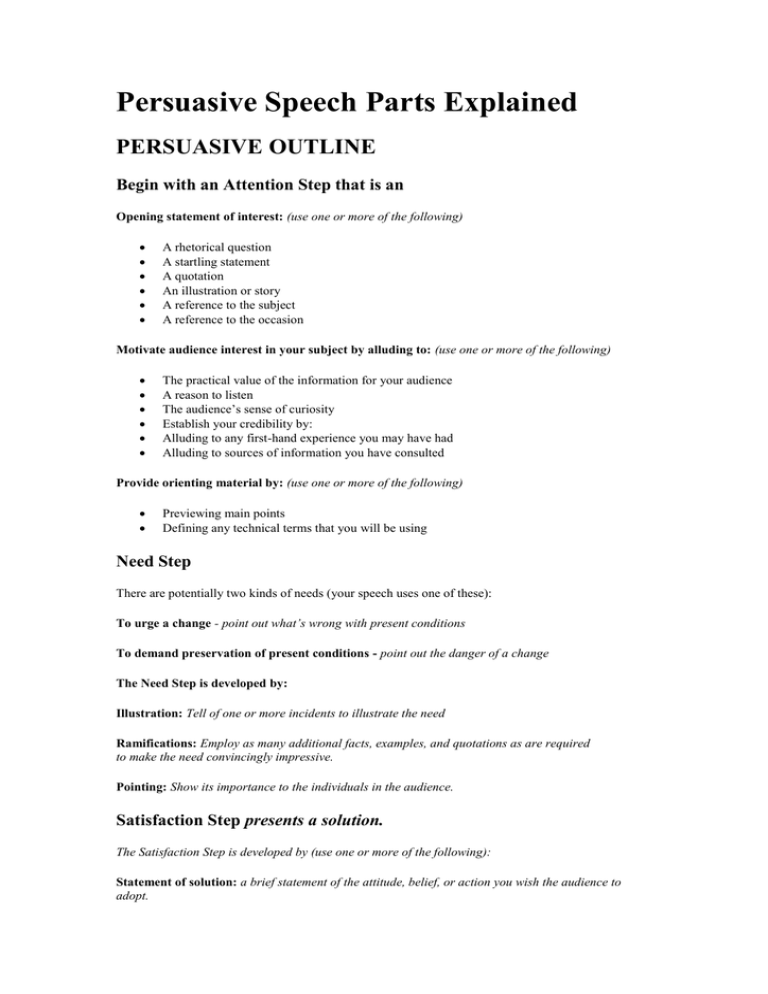
Persuasive Speech Parts Explained PERSUASIVE OUTLINE Begin with an Attention Step that is an Opening statement of interest: (use one or more of the following) A rhetorical question A startling statement A quotation An illustration or story A reference to the subject A reference to the occasion Motivate audience interest in your subject by alluding to: (use one or more of the following) The practical value of the information for your audience A reason to listen The audience’s sense of curiosity Establish your credibility by: Alluding to any first-hand experience you may have had Alluding to sources of information you have consulted Provide orienting material by: (use one or more of the following) Previewing main points Defining any technical terms that you will be using Need Step There are potentially two kinds of needs (your speech uses one of these): To urge a change - point out what’s wrong with present conditions To demand preservation of present conditions - point out the danger of a change The Need Step is developed by: Illustration: Tell of one or more incidents to illustrate the need Ramifications: Employ as many additional facts, examples, and quotations as are required to make the need convincingly impressive. Pointing: Show its importance to the individuals in the audience. Satisfaction Step presents a solution. The Satisfaction Step is developed by (use one or more of the following): Statement of solution: a brief statement of the attitude, belief, or action you wish the audience to adopt. Explanation: Make sure that your proposal is understood. Theoretical demonstration: show how the solution logically and adequately meets the need pointed out in the need step, point-by-point! Practical experience: actual examples showing where this proposal has worked effectively or where the belief has proven correct. Meeting objections: forestall opposition by showing how your proposal overcomes any objections which might be raised. Visualization Step: The visualization step must stand the test of reality. The conditions you describe must be at least realistic. The more vividly you make the situation seem, the stronger will be the reaction of the audience. There are three methods of visualizing the future. (use one or more of the following): Positive: Describe the conditions if your solution is actually carried out. Picture the listeners in that situation actually enjoying the safety, pleasure, or pride that your proposal will produce. Negative: Describe conditions if your solution is not carried out. Picture the audience feeling the bad effects or unpleasantness that the failure to effect your solution will produce. Contrast: Combination of 1 and 2. Begin with the negative method (undesirable situation) and conclude with the positive method (desirable solution). Action Step: developed by (use one or more of the following): Restatement of main idea and summary of main points. Statement of specific action or attitude change you want from the audience. A statement of your personal intent to take the course of action or attitude recommended. A concluding statement to recapture interest (a reason to remember). Blank Outline you can use for planning and writing your speech Purpose: ATTENTION STEP I. Opening Statement of Interest A. Reason (s) to Listen B. Speaker Credibility C. Thesis Statement NEED STEP II. Statement of Need A. Illustration B. Ramifications 1. 2. C. Pointing SATISFACTION STEP III. Statement of Solution A. Explanation of Solution B. Theoretical Demonstration 1. 2. 3. C. Practical Experience D. Meeting Objections 1. 2. VISUALIZATION STEP IV. Restatement of Proposed Solution A. Negative Visualization B. Positive Visualization ACTION STEP V. Restatement and Summary A. Statement of Specific Action or Attitude Change B. Statement of Personal Interest C. Reason to Remember SOURCES: 1. 2. 3. 4. 5.

